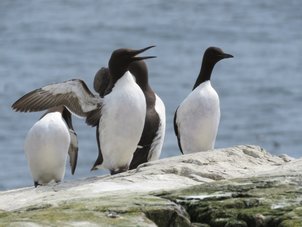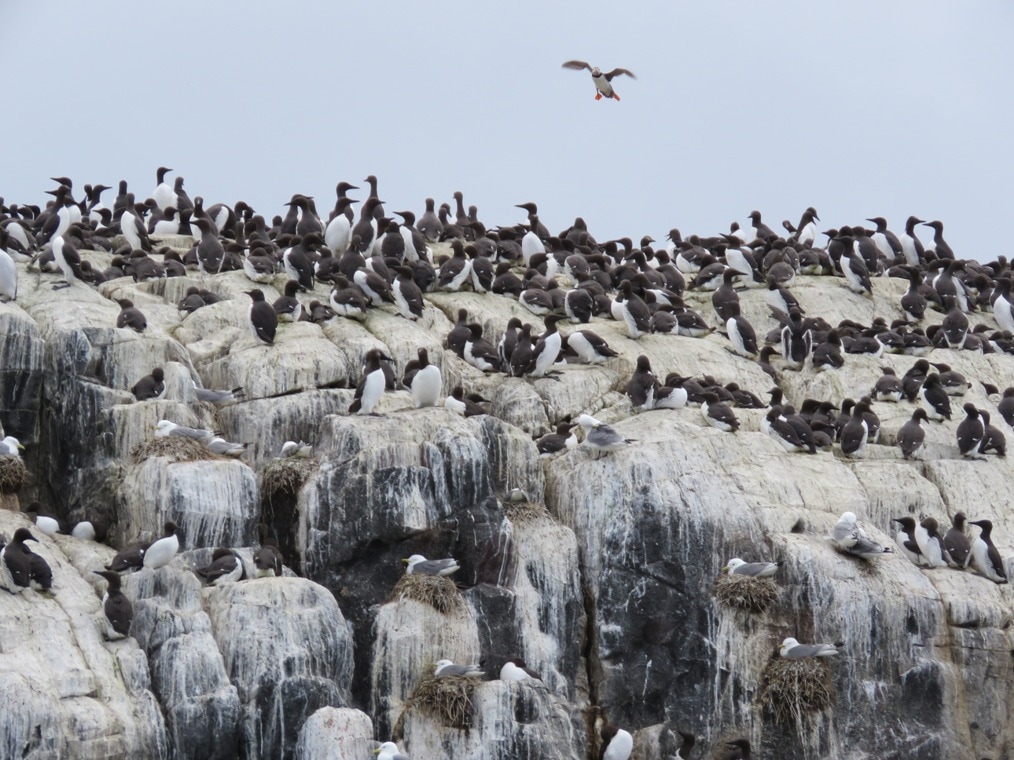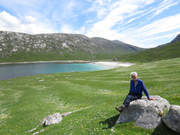 Guillemots on Staple Island, Outer Farne
Guillemots on Staple Island, Outer Farne Celtic Christianity took root on Iona off the west coast and was translated to the east, to Holy Island, Lindisfarne. Lindisfarne Castle rises on igneous rock, an intrusion of the dolerite of the Whin Sill. Dunstanburgh Castle and Bamburgh are sited on outcrops of this same geology. The cliffs at Cullernose Point, on the Northumbrian coast, show the columnar structure of dolerite, entablatures which determine the distribution of nests of the kittiwake colony we observe. Columnar, not the horizontal strata of cliff ledges.
Consider seabirds in a spectrum of time : Natural History. A day on the Farnes but what’s the historical context? Trips to Holy Island, LIndisfarne and a day in Durham at St Cuthbert’s shrine focus on Northumbria in 7th century and Celtic Christianity. Melvyn Bragg’s excellent series: The Matter of the North delves further. Research on the Lindisfarne Gospels, written to venerate Saint Cuthbert, shows there are ninety colours in the illuminated manuscripts, all derived from lichens, flowers, minerals collected by monks on these islands. In the cosiness of a well-lit study, writing on a computer, I try to imagine the monk Eadfrith creating these beautiful manuscripts on Lindisfarne.
The full day trip to the Farnes gives a wealth of material, but it is a snapshot in time. A single day. I think it through in the context of all the seabird cliffs I’ve known over the years. All I have experienced, and what I have not seen., what few of us see. Like guillemot chicks jumping off a sheer cliff at three weeks, not yet able to fly, and reaching the safety of the sea below- if they judge it right. I’ve seen it in Svalbard, in the Arctic circle, but not in Britain. Seabirds like guillemot, razorbill and puffin are specialized divers, in their element at sea. Puffin dive to a depth of 60 metres , guillemot to 180 metres. They are supreme divers, adapted to their underwater environment. Different species cram tight in crowded territories on the cliffs but each has its own feeding strategy which can determine whether the species thrives.
We crowded close upon the seabirds of Farne. A day at Dunstanburgh in mist and rain gave solitudes with seabirds. No-one else wandered the castle ruins on their headland. In full waterproofs, we sat having lunch in the shelter of the castle wall looking out at the sea pounding Queen Margaret’s Cove, and listening to the cries of kittiwakes. We peered over the fence at Gull Crag, through sea-pinks, wild thyme, scurvy and sea-campion to razorbill on lichened rocks, their plumage with water droplets our camera lenses with rain drops too. I was struck by the thought that Chris Packham and team and boatloads of visitors to the Farnes have photo archives of the same birds, Cathy the Springwatch shag and the eider who sat patiently on her eggs before the noisy colony of sandwich tern. That Dunstanburgh day was imbued with solitude.
In preparing to give illustrated talks based around this 2016 visit to Northumbria I wanted to draw out certain unifying themes: Seabirds, geology and Celtic Christianity from Iona, Staffa and the west coast to Lindisfarne and the Farne Islands in the east.
So what is the bigger picture? How do seabirds fare about the British Isles? It’s that tension between what the images show and what is actually happening I want to consider.
Reference material:
Tim Birkhead The Most Perfect Thing, a bird's egg
Melvyn Bragg: The Matter of the North.
Spring Watch 2016 on the Farne Islands ( the team arrived shortly after we left.)
Adam Nicolson: Sea room, The Last Seabird Summer?


 RSS Feed
RSS Feed